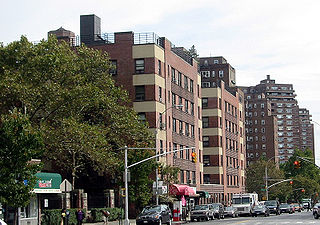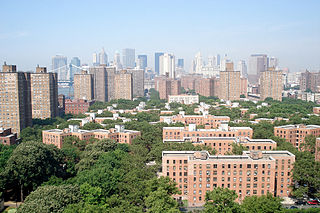
The Lower East Side, sometimes abbreviated as LES, is a historic neighborhood in the southeastern part of Manhattan in New York City. It is located roughly between the Bowery and the East River from Canal to Houston streets.

Avenue D is the easternmost named avenue in the East Village neighborhood of Manhattan, New York City, east of Avenue C and west of the FDR Drive. It runs through East 13th and Houston Streets, and continues south of Houston Street as Columbia Street until Delancey Street and Abraham E. Kazan Street until its end at Grand Street. Avenues A, B, C and D are the origin of the name of the section of the East Village neighborhood through which they run, Alphabet City.

The New York City Housing Authority (NYCHA) is a public development corporation which provides public housing in New York City, and is the largest public housing authority in North America. Created in 1934 as the first agency of its kind in the United States, it aims to provide decent, affordable housing for low- and moderate-income New Yorkers throughout the five boroughs of New York City. NYCHA also administers a citywide Section 8 Leased Housing Program in rental apartments. NYCHA developments include single and double family houses, apartment units, singular floors, and shared small building units, and commonly have large income disparities with their respective surrounding neighborhood or community. These developments, particularly those including large-scale apartment buildings, are often referred to in popular culture as "projects."
Stanton Street is a west-to-east street in the New York City borough of Manhattan, in the neighborhood of the Lower East Side. The street begins at the Bowery in the west and runs east to a dead end past Pitt Street, adjacent to Hamilton Fish Park. A shorter section of Stanton Street also exists east of Columbia Street; it was isolated from the remainder of the street in 1959 with the construction of the Gompers Houses and the Masaryk Towers.

Cooperative Village is a community of housing cooperatives on the Lower East Side of Manhattan, New York City. The cooperatives are centered on Grand Street in an area south of the entrance ramp to the Williamsburg Bridge and west of the FDR Drive. Combined, the four cooperatives have 4,500 apartments in twelve buildings.

Essex Street is a north-south street on the Lower East Side of the New York City borough of Manhattan. North of Houston Street, the street becomes Avenue A, which goes north to 14th Street. South of Canal Street it becomes Rutgers Street, the southern end of which is at South Street.

The Robert Fulton Houses is a housing project located in the Chelsea neighborhood in the New York City Borough of Manhattan and is owned and operated by the New York City Housing Authority (NYCHA). The 6.27-acre (2.54 ha) site is located between West 16th and 19th Streets and bounded by Ninth and Tenth Avenues. The project consists of 945 apartments in eleven buildings; three of the developments are 25 stories, while the others are 6 stories high.

The Jacob Riis Houses are a public housing project managed by the New York City Housing Authority (NYCHA) in the East Village in New York City. The project is located between Avenue D and the Franklin D. Roosevelt Drive, spanning two superblocks from 6th Street to 13th Street. The project consists of thirteen buildings, between six and 14 stories each, containing 1,191 apartment units.

The John Haynes Holmes Towers is a public housing project for low income residents of the Yorkville section of the Upper East Side located just south of the neighborhood's northern limit at 96th Street, in New York City, New York, United States. The neighboring Isaacs Houses and the Holmes Towers border East Harlem, which has the second highest concentration of public housing in the United States. The two public housing buildings, designed by Architects Eggers and Higgins, were completed in 1969, are 25 stories tall and contain 537 apartments. The project is located between 92nd and 93rd Streets from 1st Avenue to York Avenue and the FDR Drive.

Governor Alfred E. Smith Houses, or the Alfred E. Smith Houses. is a public housing development built by the New York City Housing Authority in the Two Bridges neighborhood of the Lower East Side of Manhattan. There are 12 buildings in the complex; all are 17 stories tall. It covers 21.75 acres (8.80 ha), has 1,931 apartments, and houses an estimated 5,739 people. The grounds are bordered by St. James Place to the west, Madison Street to the north, Catherine Street to the east, and South Street to the south.

Bernard M. Baruch Houses, or Baruch Houses, is a public housing development built by the New York City Housing Authority (NYCHA) on the Lower East Side of Manhattan. Baruch Houses is bounded by Franklin D. Roosevelt East River Drive to the east, E. Houston Street to the north, Columbia Street to the west, and Delancey Street to the south. The complex, the largest NYCHA development in Manhattan, occupies 27.64 acres (111,900 m2), of which buildings cover 13.4%, a percentage similar to that of most "tower in the park" project designs. It has 2,194 apartments, which house an estimated 5,397 people. These apartments are distributed throughout 17 buildings. Baruch Houses I is seven stories tall, Baruch Houses XI, XIII, and XV are thirteen stories tall, and the rest are fourteen stories tall. Combined, these buildings have 2.9 million square feet (270,000 m2).
Bracetti Plaza, or Mariana Bracetti Plaza, is a public housing development built and maintained by the New York City Housing Authority in Alphabet City, a section of the East Village neighborhood of Manhattan. The development is named after Mariana Bracetti (1825-1903), a legendary Puerto Rican woman who was known as the "Arms of Gold", and who was the first to craft the Boriquas Latin Cross, Puerto Rico's first flag. The flag was designed by Dr. Ramon Emeterio Betances, and is still a symbol of the Puerto Rican independence movement.

Rafael Hernandez Houses, also known as Hernandez Houses, is a public housing development built and maintained by the New York City Housing Authority (NYCHA) on the Lower East Side of Manhattan.

Mayor Fiorello H. LaGuardia Houses, also known as LaGuardia Houses, is a public housing development built and maintained by the New York City Housing Authority (NYCHA) on the Lower East Side of Manhattan. Mayor Fiorello H. LaGuardia Houses is composed of thirteen buildings, all of which are sixteen stories tall. The buildings have 1,093 apartments and house approximately 2,596 people. The complex occupies 10.96 acres (4.44 ha), and is bordered by Madison Street to the north, Montgomery Street to the east, Cherry Street to the south, and Rutgers Street to the west. LaGuardia Houses Addition is a sixteen-story tower for elderly people at the corner of Jefferson Street and Cherry Street.
Lower East Side I Infill, or Lower East Side Infill #1, is a public housing development built and maintained by the New York City Housing Authority on the Lower East Side of Manhattan.

Rutgers Houses, also known as Henry Rutgers Houses, is a public housing development built and maintained by the New York City Housing Authority (NYCHA) on the Lower East Side of Manhattan. Rutgers Houses is composed of five 20 story buildings on 5.22 acres (21,100 m2), with 721 apartments housing approximately 1,675 people. The complex is bordered by Madison Street to the north, Rutgers Street to the east, Cherry Street to the south, and Pike Street to the west.

Vladeck Houses is a public housing development built and maintained by the New York City Housing Authority on the Lower East Side of Manhattan.
Governor DeWitt Clinton Houses, also known as DeWitt Clinton Houses or Clinton Houses, is a public housing development built and maintained by the New York City Housing Authority (NYCHA) in the Spanish Harlem neighborhood of Manhattan. Clinton Houses is composed of six buildings, resting on a non-continuous campus with an area of 5.6 acres (23,000 m2). Five of those (I-V) are 18 stories high, and another (VI) is nine stories high. The six buildings have a total of 749 apartments, which house 1,823 people. Clinton Houses occupies the two blocks that are bordered by East 110th Street to the north, Lexington Avenue to the east, Park Avenue to the west, and East 108th Street to the south. It also occupies the western half of the two blocks that are bordered by East 106th Street to the north, Lexington Avenue to the east, Park Avenue to the west, and East 104th Street to the south, with the exception of a small part along East 106th Street.

Essex Crossing is an under-construction mixed-use development in New York City's Lower East Side, at the intersection of Delancey Street and Essex Street just north of Seward Park. Essex Crossing will comprise nearly 2,000,000 square feet (200,000 m2) of space on 6 acres and will cost an estimated US$1.1 billion. Part of the existing Seward Park Urban Renewal Area (SPURA), the development will sit on a total of nine city blocks, most of them occupied by parking lots that replaced tenements razed in 1967.
The Bay View Houses is a housing project of the New York City Housing Authority in the Canarsie neighborhood of Brooklyn. It has twenty-three, 8-story buildings with 1,609 apartments. The 34.02-acre complex is bordered by Seaview Avenue, East 102nd Street, and Rockaway Parkway.














